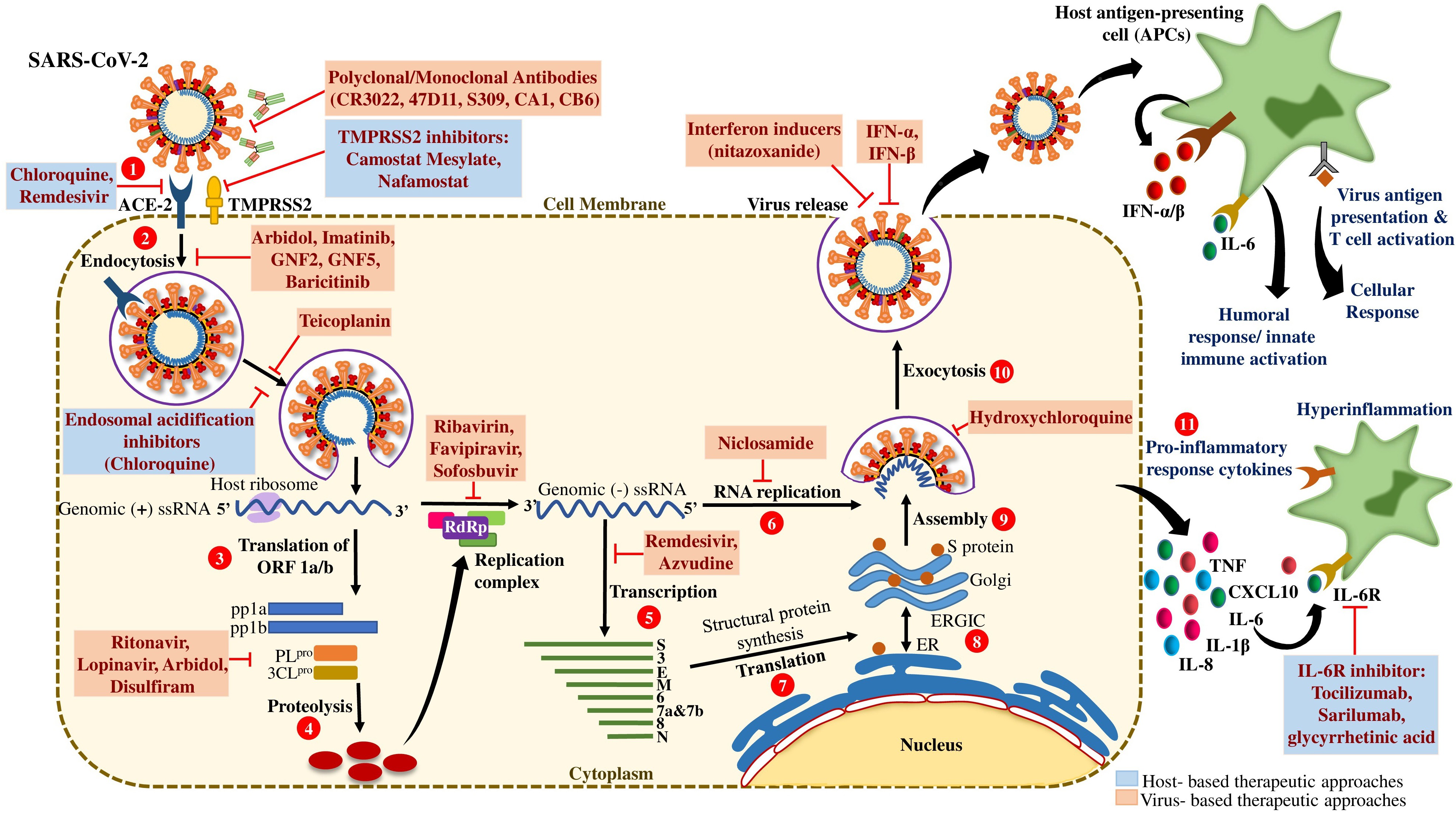Fig. 3. Illustration of the SARS-CoV-2 viral lifecycle in the host cell and potential therapeutic targets. SARS-CoV-2 entraps the host machinery to translate, replicate, and transcribe the viral genome as well as its structural protein and then reassembles, encapsulates, and exocytose mature virion out of the cell. (1) Attachment of SARS-CoV-2 to the surface receptor of the host cell: SARS-CoV-2 enters the host cell by binding the viral spike (S) protein to the host cell receptor ACE-2. The S protein is cleaved into S1 and S2, S1 region binds to the host ACE-2 receptor, and S2 which is activated by TMPRSS2 allows membrane fusion. (2) Endocytosis: After attaching to the host cell, the SARS-CoV-2 RNA is trafficked into the cell by cathepsin L mediated endocytosis and released into the cell by endosomal acidification. (3 & 4) Translation and Proteolysis: The genomic RNA is then released in the cytoplasm and encodes multiple structural and nonstructural polypeptide genes. The host machinery is used to translate ORF1a and ORF1b into pp1a and pp1ab (polyproteins), which are cleaved into 16 nonstructural effector proteins by 3CLpro and PLpro. Some nonstructural proteins form a 'replication-transcription complex', including the viral RNA-dependent RNA polymerase (RdRp) and helicase (Hel). (5 & 6) Transcription and Replication: Replication-transcription complex then uses (+) stranded genomic RNA as a template and synthesizes (─) strand genomic RNA template, which later is used to replicate the complete viral RNA genome and sub-genomic mRNA templates. (7) Translation of structural and accessory protein: In the course of transcription, a subset of 7-9 subgenomic mRNAs encoding structural proteins (S, E, M, and N and a set of accessory proteins) are produced. (8) Trafficking of viral protein from the ER to the Golgi: After newly synthesis, viral structural and accessory proteins are migrated from the endoplasmic reticulum (ER) to the Golgi apparatus. (9) Virion Assembly: A combination of genomic RNA and viral proteins are subsequently assembled into virions in budding Golgi lumen. (10) Exocytosis: Afterwards, the virions are discharged through exocytosis from the infected cell. (11) Immune activation: Upon viral infection, the infected epithelial/endothelial cells secret type I interferons, pro-inflammatory cytokines, and chemokines. This creates an anti-viral state leading to the recruitment of additional immune cells that result in viral clearance with minimal inflammation and damage. In a severe SARS-CoV-2 infection condition, an uncontrolled inflammatory response resulting from the release of large amounts of pro-inflammatory cytokines by immune effector cells results in hyperinflammation and cytokine storm leading to ARDS. Virus- and Host-based therapeutic approaches are highlighted in orange and blue, respectively. +, positive-strand RNA; −, negative-strand RNA; ACE-2, Angiotensin-converting enzyme 2; CCL2, C-C motif chemokine ligand 2; CXCL10, C-X-C motif chemokine 10; ER, endoplasmic reticulum; ERGIC, ER-Golgi intermediate compartment; IFN-α and β, Interferon- α and -β; IL-6, Interleukin 6; IL-8, Interleukin 8; mAb, monoclonal antibody; ORF, open reading frame; RdRp, RNA-dependent RNA polymerase; ssRNA, single-stranded RNA; TMPRSS2, Transmembrane protease serine 2; TNF, Tumor necrosis factor.
